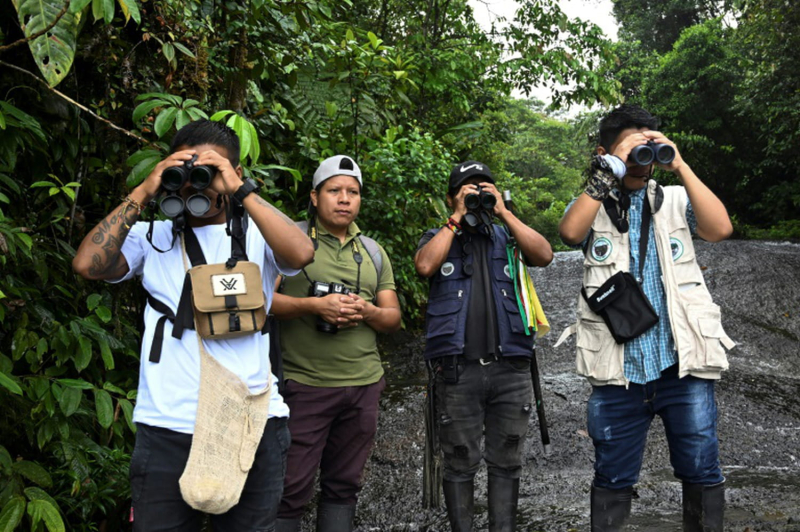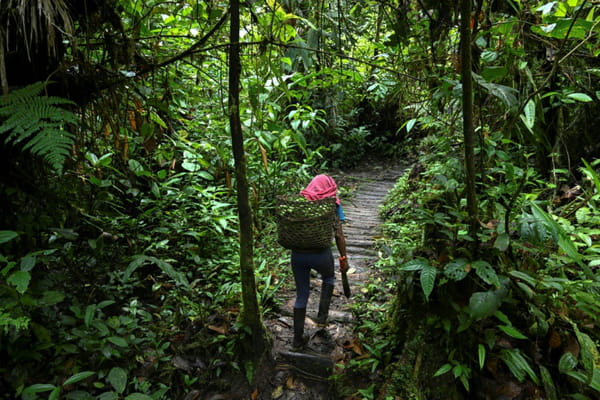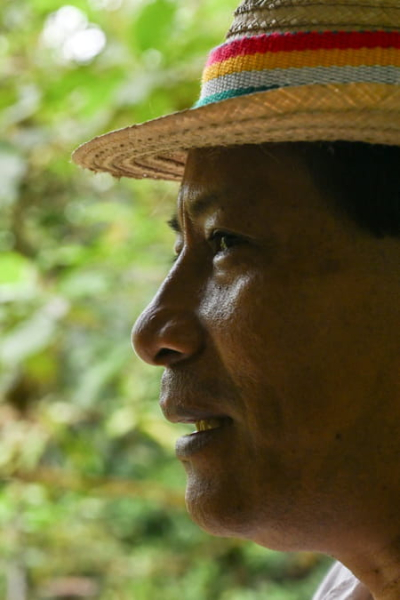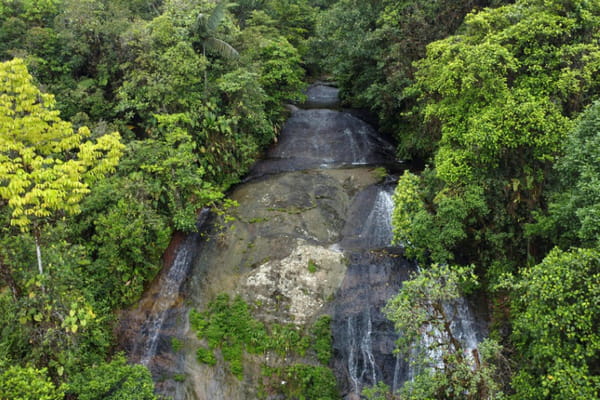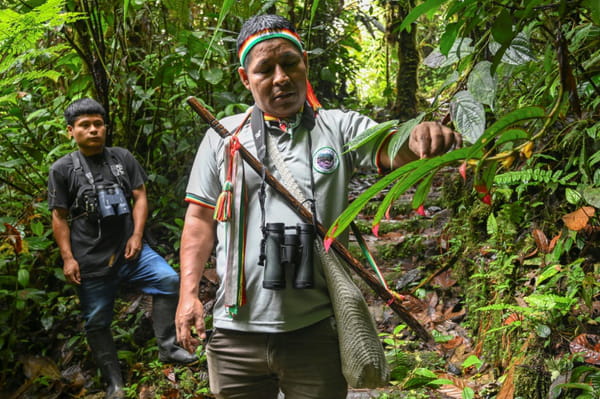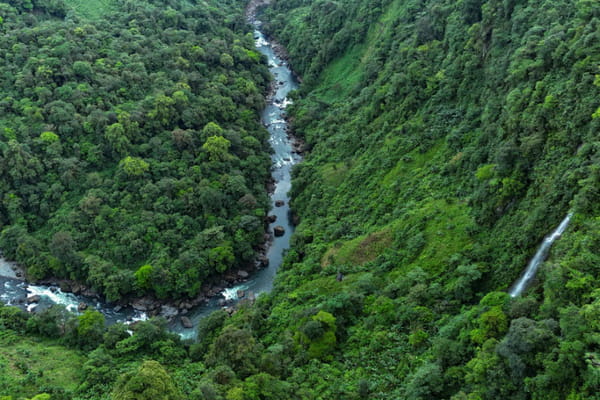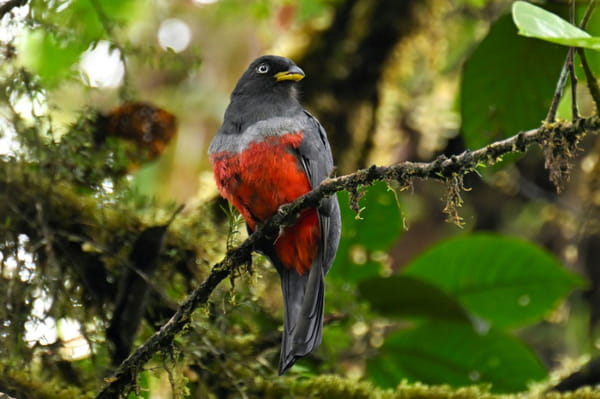They are one of the most threatened indigenous peoples in Colombia s by violence, whose territory has been subjected for decades to the predation of armed groups. As COP16 on biodiversity is being held in Cali, the Awas embody the struggle for the survival of indigenous peoples and the defense of the forest, but also an inspiring vision of a world “connected” to nature. “The Awa people have been resisting for 500 years. Against invasion, discrimination, armed groups, forced recruitment and displacement, acculturation…”, lists Olivio Bisbicus, one of the leaders of this community of nearly 50,000 souls. A woman carries green plantains in the El Gran Sabalo indigenous reserve, near El Diviso, in the Narino department, Colombia, on August 31, 2024 © AFP – JOAQUIN SARMIENTO The “Inkal Awá” by their full name, or “people of the jungle” in their ancestral Awapit language, live in the Amazonian foothills of the Narino department (southwest), one of the most troubled in Colombia. Their territory extends to neighboring Ecuador over more than 600,000 hectares of tropical mountain forests, noted AFP, which stayed there in the municipality of Barbacoas, within the private nature reserve of La Nutria, a successful attempt at “integral protection of Awa life and culture.” – “Risk of extermination” – “Three armed groups are fighting over this strategic border region, a drug trafficking corridor to the Pacific,” and full of illegal gold mines, Alex Javier Gonzalez, Undersecretary for Peace in the governorate of Narino, explained to AFP, who judges “the situation critical for the Awas.” Indigenous leader and governor of the Awa ethnic group, Olivio Bisbicus Pascal, in the El Gran Sabalo indigenous reserve near El Diviso, in the Narino department, Colombia, on August 31, 2024 © AFP – JOAQUIN SARMIENTO The Colombian justice system has documented 25 years of violence against this people, at the height of the conflict with the Marxist FARC, noting a “risk of physical, cultural and spiritual extermination.” Between 1990 and 2016, the guerrillas killed 185 Awa. These assassinations continued after the 2016 peace agreement: at least 22 in 2022, including a recognized leader, riddled with bullets by armed men with whom he came to negotiate. In early 2023, the ombudsmen of Colombia and Ecuador issued a joint alert on the fate of this people. The Colombian Constitutional Court issued three rulings demanding their protection. Nothing works. Three Awa men were executed in late August, according to Unipa, one of their representative organizations. – “And yet they are holding on” – “And yet they are holding on,” Mr. Gonzalez is surprised, “the Awas have managed to maintain control over their lands.” Aerial view of the El Gran Sabalo indigenous reserve, near El Diviso, in the Narino department, Colombia, on August 31, 2024 © AFP – JOAQUIN SARMIENTO “Their fight is emblematic, they show great courage,” confides Gilles Bertrand, the ambassador of the European Union, who accompanies them with several member states and the UN. “They are the typical example of these communities at risk of extinction, under constant pressure from criminal armed groups,” Jan Egeland, former UN official, head of the Norwegian Refugee Council (NRC), told AFP. “They refuse to give in. And for that they pay a very heavy price.” “Being an Awa chief is complicated and dangerous,” Mr. Bisbicus confirms half-heartedly. “Drug trafficking brings vice, disharmony of the territory, the destruction of our culture and nature,” he notes bitterly. “Faced with weapons, we are empty-handed. But we have dialogue, and our ancestral knowledge, our identity, our authorities, our presence here for centuries…” Armed with simple sticks and non-violent, the Unipa indigenous guard, made up of 2,000 volunteers, has put in place “self-protection” measures. An indigenous environmental guard observes a plant in the El Gran Sabalo reserve, near El Diviso, in the Narino department, Colombia, on August 31, 2024 © AFP – JOAQUIN SARMIENTO “We have been able to maintain the unity of our people, and demand respect for our territory. Our land is not a battlefield,” Mr. Bisbicus. “Today, the Awa people are trying to reclaim their destiny,” he continues, brandishing the traditional stick made of tall, straight palm wood, a symbol of a “good and beautiful life” according to the Awas. – “Spiritual bond” – Guardians of the forest, the Awas are also characterized by the strong “connection” and “spiritual bond” with their land. “The territory is a living space, where we coexist with nature, animals and spirits. Nature is our mother,” says Wilmer Rigoberto Bisbicus, coordinator of Nutria. Aerial view of the El Gran Sabalo indigenous reserve, near El Diviso, in the Narino department, Colombia, on August 31, 2024 © AFP – JOAQUIN SARMIENTO Walking in the jungle alongside them is enough to feel this impalpable but powerful bond. “Here it rains a lot. This water is life, it harmonizes,” explains Alvaro Pai, a guide at the reserve. At almost 1,000 meters above sea level, La Nutria hides an enchanting waterfall overlooking a green valley. “The waterfall listens and heals you. You can come and talk to it at dawn, against the stone wall. You have to spit on it to greet it and not let it take offense at your presence. That's how the ancients did it,” describes Alvaro Pai. A bird in the reserve indigenous El Gran Sabalo, near El Diviso, in the Narino department, Colombia, August 31, 2024 © AFP – JOAQUIN SARMIENTO Described by the ambassador of the EU as an “ambitious peace and ecotourism project”, the 365 hectares of Nutria are home to 185 species of birds multicolored, magnificent butterflies, frogs hidden at random in sunken paths and tortuous roots. Wilmer Rigoberto Bisbicus gives a glimpse of the rich cosmogony of the Awas: “We are linked to the four worlds, underground, human, spirits, and that of the Gods, stars and stars”. “These worlds are connected. If we make one suffer, we make all the others suffer.” “We must take care of the earth, because it is from it that we come, it is from it that we learn and it is to it that we will return,” emphasizes Olivio Bisbicus. “The further we get away from it, the more we hurt ourselves.” All reproduction and representation rights reserved. © (2024) Agence France-Presse